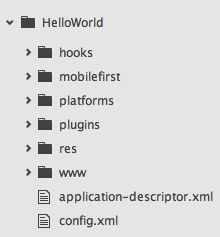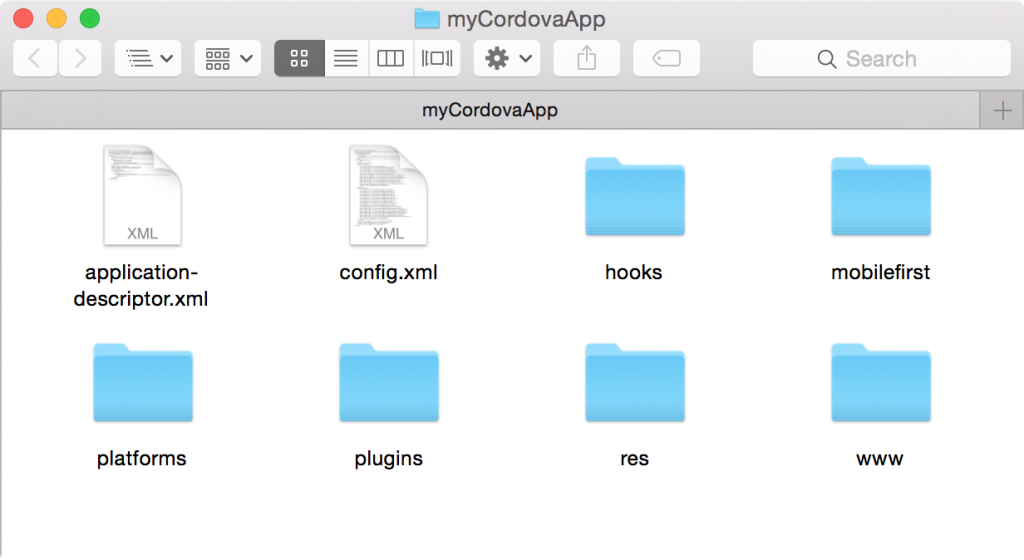- Cordova CLI commands
mfp cordova create- Creating a Cordova project
- Cordova project structure
- MobileFirst Platform initialization flow
- Previewing the application web resources
//MobileFirst Development Server should be running.
//If not yet available, use the mfp create command to setup a new MobileFirst back-end project
//followed by the mfp start command to initialize MobileFirst Server.
mfp create MyMFPProject
cd MyMFPProject
mfp start
mfp cordova preview- Testing an application on an emulator or device
//To run the application by using the Android Emulator or the iOS Simulator
mfp cordova emulate
//you can plug a device into your computer and test the app directly
mfp cordova run
- Managing Cordova platforms
//run and select the platform
mfp cordova platform add
//List available platforms in Cordova app:
mfp cordova platform list
//Remove a platform:
mfp cordova platform remove- Managing Cordova plug-ins
//manage the plug-ins used in the Cordova project
mfp cordova plugin [option]- Registering applications
//Registering applications to a local development server
mfp push
//Registering applications to a remote development server
mfp server add-
Supported MobileFirst features
-
Integrating IBM MobileFirst Platform Foundation SDK in Cordova applications
-
Integrating IBM MobileFirst Platform Foundation SDK in Cordova applications- Sampple
NAME
mobilefirst cordova
SYNOPSIS
mfp cordova <command> [options]
DESCRIPTION
IBM MobileFirst Platform Command Line Interface (CLI) for Cordova specific
actions.
Specific help for each command is available. For example:
mfp help cordova create
GLOBAL COMMANDS
config .............................. View or alter configuration settings
PROJECT COMMANDS
cordova create .............................. Creates a new Cordova project
cordova emulate .................................. Emulates Cordova project
cordova platform ................................ Manages project platforms
cordova plugin .................................... Manages project plugins
cordova prepare ............................... Prepares a Cordova project
cordova preview ......................... Previews existing Cordova project
cordova run .......................................... Runs Cordova project
COMMAND-LINE FLAGS/OPTIONS
-v, --version ...............Prints out the version number of this utility
-d, --debug ........................Debug mode produces a debug log output
-dd, --ddebug ................... Debug mode produces a verbose log output
EXAMPLE USAGE
$ mfp cordova create myapp --platform android
$ cd myapp
$ mfp cordova preview
$ mfp cordova emulate --platform android
Warning: using node version v0.12.2 which has been deprecated. Please upgrade to the latest node version available (v6.x is recommended).
Synopsis
cordova command [options]
Global Commands
create ........ Create a project
help .......... Get help for a command
telemetry ..... Turn telemetry collection on or off
config ........ Set, get, delete, edit, and list global cordova options
Project Commands
info .......... Generate project information
requirements .. Checks and print out all the requirements for platforms specified
platform ...... Manage project platforms
plugin ........ Manage project plugins
prepare ....... Copy files into platform(s) for building
compile ....... Build platform(s)
clean ......... Cleanup project from build artifacts
run ........... Run project (including prepare && compile)
serve ......... Run project with a local webserver (including prepare)
Learn more about command options using 'cordova help <command>'
Aliases
build -> cordova prepare && cordova compile
emulate -> cordova run --emulator
Options
-v, --version ........... prints out this utility's version
-d, --verbose ........... debug mode produces verbose log output for all activity,
--no-update-notifier .... disables check for CLI updates
--nohooks ............... suppress executing hooks (taking RegExp hook patterns as parameters)
Examples
cordova create myApp org.apache.cordova.myApp myApp
cordova plugin add cordova-plugin-camera
cordova platform add android
cordova plugin add cordova-plugin-camera --nosave
cordova platform add android --nosave
cordova requirements android
cordova build android --verbose
cordova run android
cordova build android --release -- --keystore="..\android.keystore" --storePassword=android --alias=mykey
cordova config ls
cordova platform add ios --nofetch
cordova plugin add cordova-plugin-camera --nofetch#Cordova project structure
After the Cordova project is created, the following files and folders are generated. This project structure follows the standard Cordova project structure:
- application-descriptor.xml - Application metadata for MobileFirst
- config.xml - The Cordova configuration file with extended MobileFirst-related preferences
- hooks - The Cordova hooks folder
- mobilefirst - The folder that contains MobileFirst artifacts: .wlapp files that MobileFirst Server needs to recognize applications, as explained below
- platforms - The folder that contains Cordova platforms support
- plugins - The folder that contains Cordova plug-ins
- www - The folder that contains the application web resources
var Messages = {
// Add here your messages for the default language.
// Generate a similar file with a language suffix containing the translated messages.
// key1 : message1,
};
var wlInitOptions = {
// Options to initialize with the WL.Client object.
// For initialization options please refer to IBM MobileFirst Platform Foundation Knowledge Center.
};
// Called automatically after MFP framework initialization by WL.Client.init(wlInitOptions).
function wlCommonInit(){
// Common initialization code goes here
document.getElementById('app_version').innerText = WL.Client.getAppProperty("APP_VERSION");
document.getElementById('menu').setAttribute('style', 'display:block;');
}
var app = {
// Application Constructor
initialize: function() {
this.bindEvents();
},
// Bind any events that are required on startup. Common events are:
// 'load', 'deviceready', 'offline', and 'online'.
bindEvents: function() {
document.addEventListener('deviceready', this.onDeviceReady, false);
},
// The scope of 'this' is the event. In order to call the 'receivedEvent'
// function, 'app.receivedEvent(...);' must be explicitly called.
onDeviceReady: function() {
app.receivedEvent('deviceready');
},
// Update the DOM on a received event.
receivedEvent: function(id) {
var parentElement = document.getElementById(id);
var listeningElement = parentElement.querySelector('.listening');
var receivedElement = parentElement.querySelector('.received');
listeningElement.setAttribute('style', 'display:none;');
receivedElement.setAttribute('style', 'display:block;');
console.log('Received Event: ' + id);
},
// Trigger the vibration
vibrate: function(){
WL.Logger.info("vibrating");
navigator.vibrate(3000);
},
// Trigger the camera
getPicture: function(){
navigator.camera.getPicture(app.getPictureSuccess, app.getPictureFail, { quality: 50,
destinationType: Camera.DestinationType.FILE_URI });
},
// Receive the result from the camera
getPictureSuccess: function(imageURI){
WL.Logger.info("getPicture success "+imageURI);
document.getElementById("image").src=imageURI;
},
// Called when some error occur with the camera
getPictureFail: function(){
WL.Logger.error("getPicture failed");
},
// Execute a request to RSSAdapter/getStories
getRSSFeed: function(){
var resourceRequest = new WLResourceRequest(
"/adapters/RSSAdapter/getStories",
WLResourceRequest.GET);
resourceRequest.send().then(app.getRSSFeedSuccess,app.getRSSFeedError);
},
// Receive the response from RSSAdapter
getRSSFeedSuccess:function(response){
WL.Logger.info("getRSSFeedsSuccess");
//The response.responseJSON element contains the data received from the back-end
alert("Total RSS Feed items received:"+response.responseJSON.rss.channel.item.length);
},
// Called when some error occurs during the request to RSSAdapter
getRSSFeedError:function(response){
WL.Logger.error("Response ERROR:"+JSON.stringify(response));
alert("Response ERROR:"+JSON.stringify(response));
}
};
app.initialize();
